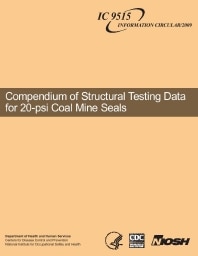Mining Publication: Compendium of Structural Testing Data for 20-psi Coal Mine Seals
Original creation date: August 2009
Authors: RK Zipf, ES Weiss, SP Harteis, MJ Sapko
NIOSHTIC2 Number: 20035801
Pittsburgh, PA: U.S. Department of Health and Human Services, Public Health Service, Centers for Disease Control and Prevention, National Institute for Occupational Safety and Health, DHHS (NIOSH) Publication No. 2009-151, Information Circular 9515, 2009 Aug; :1-143
This report presents nearly all structural data available from explosion tests of 20-psi mine ventilation seals and concrete-block ventilation stoppings that were conducted by the National Institute for Occupational Safety and Health during 1997-2008. Although the seals tested were designed to meet the former federal 20-psi pressure design standard, the structural information contained herein on these seal tests will facilitate the analysis and design of coal mine seals that meet the new explosion pressure design criteria of 50 and 120 psi as set forth in the Mine Safety and Health Administration (MSHA)’s final rule on "Sealing of Abandoned Areas." The seal testing data are organized into six broad categories of seal structures based on the materials used and the construction method for those 20-psi seals: 1. Concretelike materials with steel reinforcement and reinforcement bar anchorage to rock; 2. Pumpable cementitious materials of varying compressive strengths with no steel reinforcement and no hitching; 3. Articulated structures such as solid-concrete-block seals and ventilation stoppings made of solid and hollow-core concrete blocks; 4. Polymer and aggregate materials without hitching; 5. Wood-crib-block seals with or without hitching; 6. Articulated structures such as lightweight blocks with or without hitching. This summary contains data on 52 different structures in the above categories - 44 seals and 8 ventilation stoppings. The structural data sets include the applied loading on the tested seal represented by a pressure-time curve and, when available, the measured seal response represented by a displacement-time curve. The structural data sets enable the calibration and verification of numerical models of seal behavior at the 20-psi level, which may then facilitate future structural analyses of seal designs for the new 50- and 120-psi explosion pressure design criteria.

NIOSHTIC2 Number: 20035801
Pittsburgh, PA: U.S. Department of Health and Human Services, Public Health Service, Centers for Disease Control and Prevention, National Institute for Occupational Safety and Health, DHHS (NIOSH) Publication No. 2009-151, Information Circular 9515, 2009 Aug; :1-143